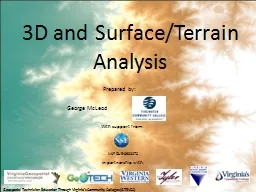

in partnership with With support from NSF DUE0903270 Prepared by George McLeod Geospatial Technician Education Through Virginias Community Colleges GTEVCC Digital Terrain Models A digital ID: 423517
Download Presentation The PPT/PDF document "3D and Surface/Terrain Analysis" is the property of its rightful owner. Permission is granted to download and print the materials on this web site for personal, non-commercial use only, and to display it on your personal computer provided you do not modify the materials and that you retain all copyright notices contained in the materials. By downloading content from our website, you accept the terms of this agreement.
Slide1
3D and Surface/Terrain Analysis
in partnership with:
With support from:
NSF DUE-0903270
Prepared by:
George McLeod
Geospatial Technician Education Through Virginia’s Community Colleges (GTEVCC)Slide2
Digital Terrain Models
A digital
terrain model is a model providing a representation of a terrain relief on the basis of a finite set of sampled data
Terrain data
refers to measures of elevation at a set of points V of the domain plus possibly a set
E of non-crossing line segments with endpoints in V
D
Slide3
Data Sampling
Regular
IrregularSlide4
Sampling effects resolutionSlide5
Our three Primary terrain Models
Digital Elevation Models (DEMS) – aka Regular Square Grids (RSGs)Triangulated Irregular Networks (TINS) – aka Polyhedral terrain modelsContour Maps – aka “topo
” mapsSlide6
The Data…
LIDAR
(
LI
ght Detection A
nd Ranging)
DEM
TINSlide7
Terrain mapping
Land surface is 3-D
Elevation data or
z-data is treated as a
cell value or a point
data attribute rather
than as a coordinate.
Introduction to the DataSlide8
Digital Elevation Model (DEM)Gridded array of elevation
points obtained from a variety sampling methodsSlide9
DEMs
A
constant function can be associated with each square (i.e., a constant elevation value). This is called a
stepped model
(it presents discontinuity steps along the edges of the squares)
DSlide10
The function defined on each square can also be a bilinear function interpolating all four elevation points corresponding to the vertices of the squareSlide11
Triangulated Irregular Network (TIN)Series of non-overlapping triangles
Elevation values are stored at nodesSources: DEMs, surveyed elevation points, contour lines, and breaklines
Breaklines are line features that represent changes of
the land surface such as streams, shorelines, ridges,
and roadsSlide12
TINs
Example of a TIN based on irregularly distributed dataSlide13
Data for Terrain Mapping and Analysis
Triangulated Irregular Network (TIN)Not every point in DEM is usedOnly points most important
VIP (Very Important Points) algorithmMaximum z-tolerance algorithmDelaunay triangulation: all nodes are connected to their nearest neighbor to form triangles which are as
equi-angular as possible.Slide14
Tins vs. Grids
Needs larger storage capacityComputationally difficult
Flexibility of data sourcesCan add pointsBetter display
More efficient
Needs smaller storage capacityComputationally simplerFixed with a given cell size
Cannot add sample pointsRaster displayLess efficient
DEM
TINSlide15
Contour
Mapping
Contouring is most common
method for terrain mappingContour lines connect points of equal elevation (
isolines)Contour intervals represent the vertical
distance between contour lines.Arrangement of contour lines
reflect topographySlide16
Digital Contour Maps
Contours are usually available as sequences of points
A
line
interpolating
points of a contour can be obtained in different ways
Examples: polygonal chains, or lines described by higher order
equations Slide17
Digital Contour Maps: properties
They are easily drawn on paper
They are very intuitive for humans
They are not good for
complex
automated
terrain analysis
Slide18
Contour Profile Mapping
Vertical profile shows changes in elevation along a line, such as a hiking trail, road or stream.Slide19
Cartographic Terrain Mapping
Hill shading is also known as a shaded relief or simply shadingAttempts to simulate how the terrain looks with the interaction between sunlight and surface features.
Helps viewers recognize the shape of land-form features on a map.Slide20
Hillshading
Four factors control the visual effect of hill-shadingSun’s azimuth is direction of incoming light (0 to 360°)The sun’
s altitude from horizon (0-90°)Surface slope (0-90°)Surface aspect (0 to 360°)Slide21
Hypsometric Tinting
Hypsometric tintingApplies different color symbols to represent
elevation or depth zones.Slide22
Methods of Analysis
Slope measures the rate of change of elevation at a surface location
Aspect is the directional measure of the slope (degrees- 4 or 8 directions)
Hillshade
, refer to previous slides
Line of sight
refers to the straight line visibility from an observer to a feature
Viewshed
analysis refers to the areas of the land surface that are visible from an observation point or points. Watershed analysis refers to an area that drains water and other substances to a common outlet. Area and volume calculationsSlide23
Connectivity Function Example:Viewshed Analysis
Image Source: Chrisman, Nicholas.(2002). 2
nd
Ed. Exploring Geographic Information Systems
. p 198. fig. 8-14.Slide24
Line of Sight AnalysisSlide25
SlopeSlide26
AspectSlide27
Hillshade
Setting a hypothetical light source and calculating the illumination values for each
cell in relation to neighboring cells. It can greatly enhance the visualization of a
surface for analysis or graphical display.
Azimuth 315
°
, altitude 45
°Slide28
Viewshed
Viewshed identifies the cells in an input raster that can be seen from one or more observation points or lines.
It is useful for finding the visibility. For instance, finding a well-exposed places for communication towers
hillshaded DEM as backgroundSlide29
Surface Area and VolumeSlide30
Application: Environmental Impact Analysis
3D landscape model impact on natural beautySlide31
Application - Flood Risk
3D height data changing water levels-danger areasSlide32
The 3rd Dimension: Height Analysis – combining several methods together
Contours Hill shading Spot height symbols Cliff & slope symbols Viewpoint symbolsSlide33
3D Terrain Analysis: Summation
GIS does not always provide exact answers to problems, but by identifying trends based on geography, GIS can reveal patterns that can help us make informed decisions.
A GIS can improve decision-making; it cannot make decisions for us.